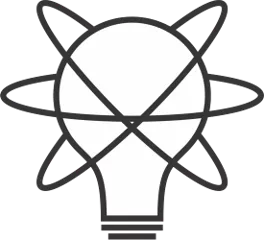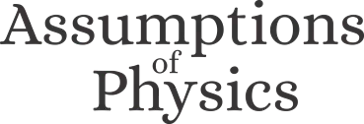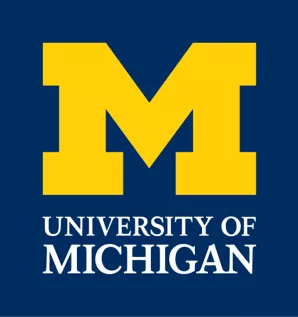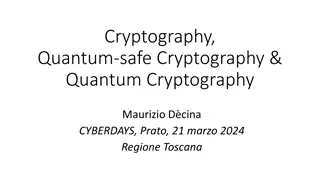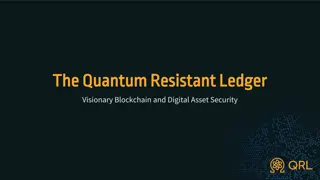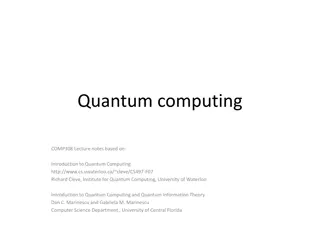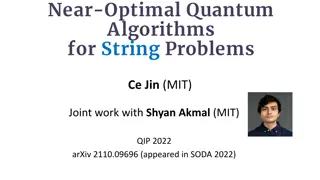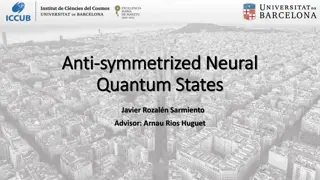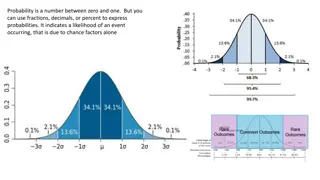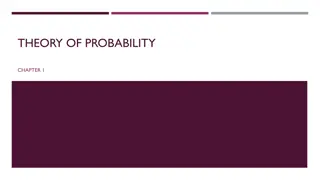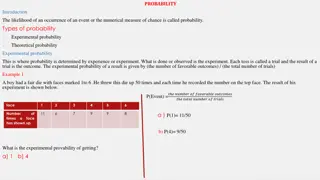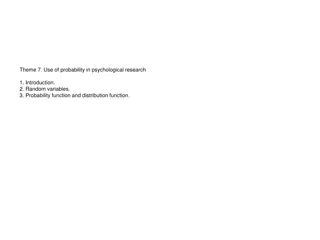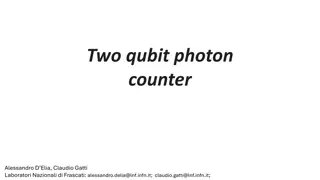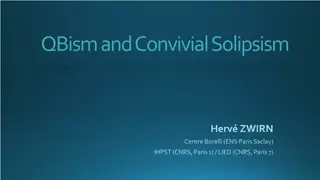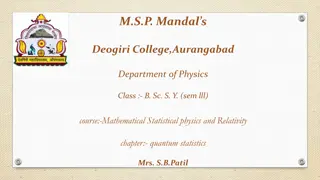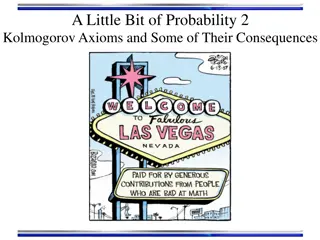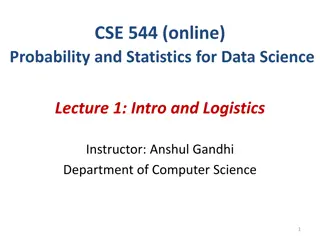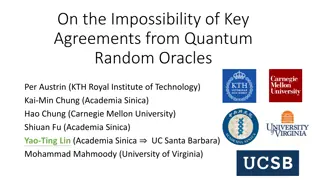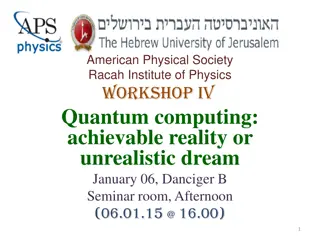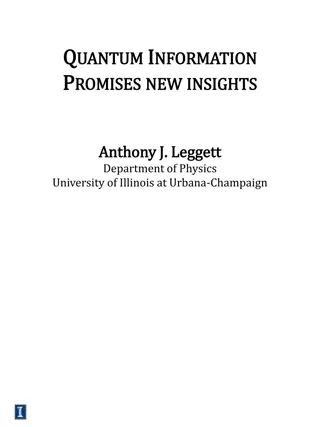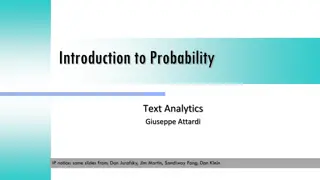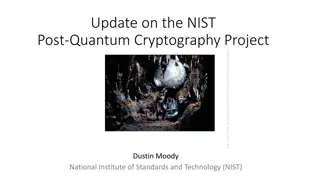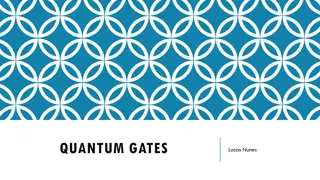Quantum Probability and Information Theory
Quantum probability and information theory challenge traditional measure theory, leading to a project aiming to derive fundamental physical assumptions from first principles. Gabriele Carcassi from the University of Michigan leads this endeavor, investigating the logical structures of classical and quantum mechanics to uncover key differences in state counting and measure theory requirements.
Download Presentation

Please find below an Image/Link to download the presentation.
The content on the website is provided AS IS for your information and personal use only. It may not be sold, licensed, or shared on other websites without obtaining consent from the author.If you encounter any issues during the download, it is possible that the publisher has removed the file from their server.
You are allowed to download the files provided on this website for personal or commercial use, subject to the condition that they are used lawfully. All files are the property of their respective owners.
The content on the website is provided AS IS for your information and personal use only. It may not be sold, licensed, or shared on other websites without obtaining consent from the author.
E N D
Presentation Transcript
Quantum probability and quantum information theory require a novel approach to measure theory Gabriele Carcassi University of Michigan
Lead a project called Assumptions of Physics https://assumptionsofphysics.org/ Find a set of minimal physical assumptions from which the laws can be rederived Reverse Physics: Start with the equations, reverse engineer physical assumptions/principles What are the basic concepts/idealizations behind the different physical theories? Physical Mathematics: Start from scratch and rederive everything from physical requirements Which mathematical structures (or which parts) are physical? Gabriele Carcassi - University of Michigan 2
Goal and Outline What exactly is the difference between classical and quantum mechanics? Can we find a key feature that is physically meaningful, is significant in an obvious way, and is sufficient to imply other features? Outline Logical structure is the same between classical and quantum mechanics Entropic/geometric/probabilistic structures form a joint structure, different between classical and quantum mechanics The difference is in how states are counted Quantum states do not describe different cases at-all-else-being equal Need new type of measure theory to bring that to light Gabriele Carcassi - University of Michigan 3
Is the difference between classical and quantum mechanics due to different rules of logic? NO: they implement the same logical structure. On the Common Logical Structure of Classical and Quantum Mechanics Andrea Oldofredi, Gabriele Carcassi, Christine A. Aidala Erkenntnis (2022) In-depth comparison Assumptions of Physics (Open Access Book) Gabriele Carcassi, Christine A. Aidala https://doi.org/10.3998/mpub.12204707 Develop a common logic framework for all scientific theories Gabriele Carcassi - University of Michigan 4
Topology and the logic of experimental verifiability Statements formally associated with an experimental test Theoretical statements ???(?) corresponds to the verifiable part of a statement Experimental verifiability topology and ?-algebras (foundation of geometry, probability, ) ?1 Test Result Verifiable statements SUCCESS (in finite time) Possibilities T ?? corresponds to the undecidable part of a statement UNDEFINED UNDEFINED F FAILURE (in finite time) ???(?) corresponds to the falsifiable part of a statement Points Open sets Open set (509.5, 510.5) Verifiable the mass of the electron is 510 0.5 KeV Closed set [510] Falsifiable the mass of the electron is exactly 510 KeV Borel sets Borel set (??? ??? = ) Theoretical the mass of the electron in KeV is a rational number (undecidable) Inference relationship ?:?? ?? such that ? ? ? Topologically continuous consistent with analytic discontinuity on isolated points ?? ?? Inference relationship Causal relationship Perfect map between math and Relationships must be topologically continuous physics ? ? Causal relationship ?:? ? such that ? ? ? Phase transition Topologically isolated regions Gabriele Carcassi - University of Michigan 5
Logic/topology/?-algebra are different aspects of the same structure, and they follow the same rules in CM and QM Where is the difference? Rules of probability? Rules of information theory? Rules of geometry? Gabriele Carcassi - University of Michigan 6
1 ??? = ? ? Classical probability ? ? Hamiltonian mechanics is conservation of information entropy Symplectic manifold Gabriele Carcassi, Christine A. Aidala https://doi.org/10.1016/j.shpsb.2020.04.004 ? ?? = log? ? Information theory ?? uniform over ? No other structure! Difference must be here. Geometry/probability/information theory are different aspects of the same structure ? ? 2 ? ? ? = ? ? Quantum probability Projective Hilbert space ? =1 2??+1 1 + ? 2 ,1 ? 2 Quantum information theory 2?? ? ? = ? Gabriele Carcassi - Physics Department - University of Michigan 7
Easiest way to show the difference? Quantum information theory: entropy cannot be negative but conditional entropy can Classical information theory (discrete): neither entropy nor conditional entropy can be negative Classical information theory (continuous): both entropy and conditional entropy can be negative Quantum mechanics mixes discrete and continuous features Neither classical/quantum can fully contain (and only contain) the other rules of geometry/probability/information theory are different in classical and quantum mechanics Gabriele Carcassi - University of Michigan 8
But how EXACTLY are they different? Note that classical geometry/probability/information theory are based on the notion of measure no measure underneath quantum mechanics Maybe measure theory is the problem? No use of measure theory ? ? ?,? = tr ??? Uses measure theory Classical hidden variables ? ?|?,? = ? ? ? ??? ??(?) WHEN is measure theory a problem? ? = ????? ?? ?? However, we do use measures on preparations and on measurements X ? ?? = tr ???? Gabriele Carcassi - Physics Department - University of Michigan 9
What IS measure theory anyway? Measure theory defines how big a set is , how many elements there are in a set , how we count ? ? [0,+ ] Countable additivity is a fundamental axiom of measure theory ? ??? = ?? ?? Disjoint sets A density is a ratio between two measures ? =?? Units of ? over units of ? ?? Radon Nikodym derivative Gabriele Carcassi - Physics Department - University of Michigan 10
What do we use measures for? Probability ? ? : how likely ? ? is true Used both in CM and QM Physical quantities ?(??): size of the set in units therefore System configurations ?(??): state count ? = ??? ? ?? ?? Present in CM, absent in QM X ? ?? = tr ???? ? ?|?,? = ? ? ? ??? ??(?) Invalid in QM Valid in QM Quantum mechanics does not provide a measure to count states! Gabriele Carcassi - Physics Department - University of Michigan 11
How can we count states in QM? In classical mechanics, count of states and entropy are linked by ? ?? = log? ? Suppose we keep this relationship in quantum mechanics. What type of measure do we get? Gabriele Carcassi - Physics Department - University of Michigan 12
Finite continuous range ?(?) Single point ?(?) log?(?) log?(?) Counting measure ? ? = #? Number of points + 1 0 + Lebesgue measure ? ?,? = ? ? < 0 < Interval size Quantized measure ? ? = 2?(??) Entropy over uniform distribution 0 < 1 < Gabriele Carcassi - Physics Department - University of Michigan 13
1. Single point is a single case (i.e. ? ? 2. Finite range carries finite information (i.e. ? ? < ) 3. Measure is additive for disjoint sets (i.e. ? ??? = ?? ??) = 1) Pick two! Discrete classical mechanics (counting measure) picks 1 and 3 Continuum classical mechanics (Lebesgue measure) picks 2 and 3 Quantum mechanics picks 1 and 2 What is quantized? The count of states! Gabriele Carcassi - Physics Department - University of Michigan 14
In quantum mechanics Measure not additive Measure not monotonic Additive on orthogonal states 1 + 1 1 + 1 = 2 1 + 1 < 2 2 + 1 < 2 Quantum mechanics requires a new approach to measure theory (which is the basis of probability theory, information theory, theory of integration, differential geometry, ) ONLY This is the source of quantum weirdness What is the physical meaning of this? Gabriele Carcassi - University of Michigan 15
Why do |?+ and |? correspond to two cases, but |?+ and |?+ correspond to fewer cases? The state of a system is never completely independent from the environment There is a cat inside a box the box is not on the surface of the sun Preparing (or measuring) |?+ and |?+ implies different boundary conditions (i.e. different preparation or measurement setup) they are not two cases all else being equal Contextuality non-additive measure Gabriele Carcassi - Physics Department - University of Michigan 16
Why should we be interested in these quantized measures? They are equivalent to what we already have in QM! Discrete measure and Lebesgue measure are (in a sense) unique Are quantized measures (in some sense) unique as well? In a field theory, one (independent) DOF at each point (i.e. local commutation relationship) Measure of volume counts independent DOFs in a region Lebesgue measure gives us regions with measure less than one less than one DOF To quantize space-time, we may need a quantized measure Gabriele Carcassi - University of Michigan 17
Conclusion Both classical and quantum mechanics are composed of two macro parts Logic/Topology/?-algebra keeps track of the logic of experimentally verifiable statements Geometry/Probability/Information Theory keeps track of the count of states The first part has the same structure (no difference in logic) The second part (as formulated right now) has a different structure Discrete, continuous and quantum spaces each have a different structure precisely because the count of states is defined differently We should study these quantized measures on their own merit See if they are unique Likely needed to quantize space-time Gabriele Carcassi - University of Michigan 18
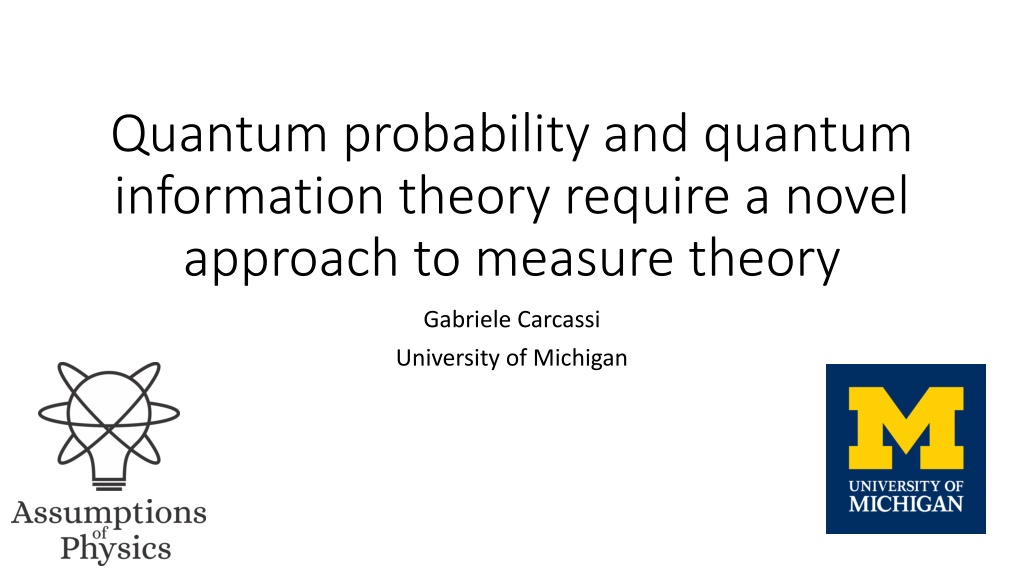
 undefined
undefined